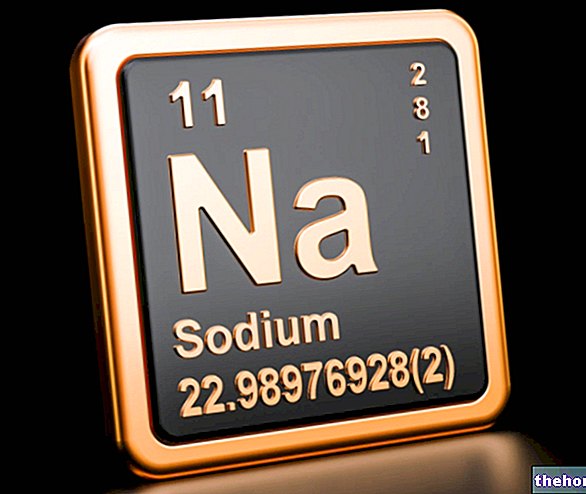
In humans, the most important compounds in this group are vitamin D3 (also known as cholecalciferol) and vitamin D2 (known as ergocalciferol) - which however will need to be mutated into calcitriol (the active hormonal form).
The main natural source of vitamin D is constituted by the endogenous production of cholecalciferol (vit D3) in the skin, starting from cholesterol, through a chemical reaction that depends on exposure to sunlight (in particular from UVB irradiation). However, cholecalciferol and ergocalciferol can also be taken with the diet and supplements, but only a few foods can be considered good sources of vitamin D (especially fish, liver and egg yolk; secondly, certain mushrooms as well).
The dietary recommendations for vitamin D have a large safety margin and, generally, do not take into account the amount of sun exposure, based entirely on the nutritional intake. This is because, by virtue of the variability linked to different latitudes (see hours of light and darkness in the Nordic countries), the uptake of UVB rays in the population is quite variable; moreover, let's not forget that "excessive exposure to the sun can increase the risk of skin cancer."
Both the vitamin D introduced with food and that produced in the skin, are biologically inactive and necessarily require the intervention of a protein enzyme capable of hydroxylating them, converting them into the biologically active form. This occurs in the liver and kidneys. Since vitamin D it can be synthesized in adequate quantities by most mammals sufficiently exposed to sunlight, it should not be considered an essential dietary factor - therefore it should not even be considered a vitamin. which produces its effects by interacting with a nuclear receptor located in several cells of different tissues.
Cholecalciferol (vit D3) is converted to calcifediol (25-hydroxycholecalciferol), while ergocalciferol (vit D2) is converted to 25-hydroxyergocalciferol. These two metabolites of vitamin D (called "25-hydroxyvitamin D" or "25 (OH ) D ") can be measured in blood serum to determine a person's total vitamin D level. Calcifediol is then further hydroxylated by the kidneys to form calcitriol (also known as" 1,25-dihydroxycholecalciferol "), the biologically form active vitamin D. Calcitriol circulates as a real hormone in the blood, playing a very important role in the homeostasis and metabolism of calcium and phosphate, regulating its concentrations in the blood and promoting the physiological growth of the skeleton, bone remodeling and preventing degeneration with old age. Calcitriol also has other biological effects, including a role on cell growth, various neuromuscular functions. and immune systems, and on the reduction of inflammation.
The discovery of vitamin D came with the search for the missing dietary substance in children with rickets (the infantile form of osteomalacia). Vitamin D supplements are therefore administered to treat or prevent osteomalacia, rickets and osteoporosis, but there is little or no scientific evidence regarding other health effects in the general population. The effect of vitamin D supplementation on mortality is not yet fully understood, although almost all research groups agree that it does not exist. no justification in recommending its integration for preventive purposes for diseases of various kinds.
steroidei is open) which show the biological activity of calciferol and are characterized by being derivatives of cyclopentanoperhydrophenanthrene. There are several forms, among which the main ones are two: vitamin D2 or ergocalciferol and vitamin D3 or cholecalciferol. The structural difference between vitamin D2 and vitamin D3 is that the side chain of D2 contains a double bond between carbons 22 and 23 and a methyl group on carbon 24.For further information: Vitamin D Skin Synthesis
Calciferol is 50-100 times more active than ergocalciferol (D3 is more active than D2). Both "ergocalciferol and calciferol are inactive forms of vitamin D" therefore "activation occurs in the liver and kidneys. L" man is able to synthesize cholecalciferol starting from a precursor, with the function of provitamin: dehydrocholesterol (derived from cholesterol by reduction). This provitamin is found in the skin, so that it absorbs the solar radiant energy that causes isomerization to cholecalciferol (see skin synthesis of vitamin D). An "adequate exposure to the sun therefore reduces the need for vitamin D.
Note: speaking of vitamin D or calciferol, without specifying any reference index, we mean vit D2 or vit D3 or both. Vitamin D2 was differentiated in 1931 while, after irradiation of 7-dehydrocholesterol, vitamin D3 was discovered in 1935.
target. The binding of calcitriol to the VDR allows it to act as a transcription factor that modulates the gene expression of transport proteins (for example TRPV6 and calbindin), in turn involved in the absorption of calcium in the intestine. Vitamin D belongs to the steroid / thyroid hormone receptor superfamily and is expressed by cells in most organs, including: brain, heart, skin, gonads, prostate and breast.
The activation of VDR in intestinal, bone, kidney and parathyroid cells leads to the maintenance of calcium and phosphorus levels in the blood (with the help of the parathyroid hormone and calcitonin) and to the preservation of the bone content.
One of the most important roles of vitamin D is the maintenance of skeletal calcium balance, promoting the absorption of calcium in the intestine, bone resorption by increasing the number of osteoclasts, maintaining calcium and phosphate levels for bone formation and allowing parathyroid hormone to function properly to maintain serum calcium levels. Vitamin D deficiency can result in lower bone mineral density and an increased risk of reduced bone density (osteoporosis) or bone fracture, because lack of Vitamin D alters the mineral metabolism in the body. Therefore, vitamin D is also essential for bone remodeling through its role as a powerful reabsorption stimulator.
VDR also regulates cell proliferation and differentiation. Vitamin D also interacts with the immune system, and VDRs are expressed in several types of white blood cells, including monocytes and activated T and B cells. In vitro, vitamin D increases the expression of the tyrosine hydroxylase gene in adrenal medullary cells and influences the synthesis of neurotrophic factors, nitric oxide synthase and glutathione.
steroids.Vitamin D is essential for the homeostasis of calcium and phosphate, and is crucial for the growth and maintenance of the skeleton. The metabolically active form is 1,25- (OH) 2-cholecalciferol, which acts by favoring:
- Absorption of calcium and phosphate in the intestine
- Deposition of calcium from the bones
- Maintenance of cartilage trophism
- Renal reabsorption of calcium and phosphorus in the proximal convoluted tubule.
Vitamin D and calcium
L "1,25- (OH) 2-cholecalciferol stimulates the synthesis of CaBP (protein that transports calcium) in the target organ (enterocytes), intervening at the level of intestinal DNA transcription that encodes the protein and plasma RNA polymerase . The use of actinomycin D and a-amanitin inhibitors of transcription and RNA polymerase respectively confirm this action. In this way, new RNA is synthesized which favors the synthesis of CaBP necessary to favor the absorption of calcium. It is now certain that cyclic AMP is involved in this process, which increases in the tissues by the action of active vitamin D.
, marine fish (herring, salmon, sardine) and egg yolk; smaller quantities are present in mushrooms. For further information: Where is itNote: almost all of vitamin D is synthesized in the skin; adequate exposure to the sun is therefore recommended, especially for the elderly.
For further information: Vitamin D in Foods


.jpg)
























